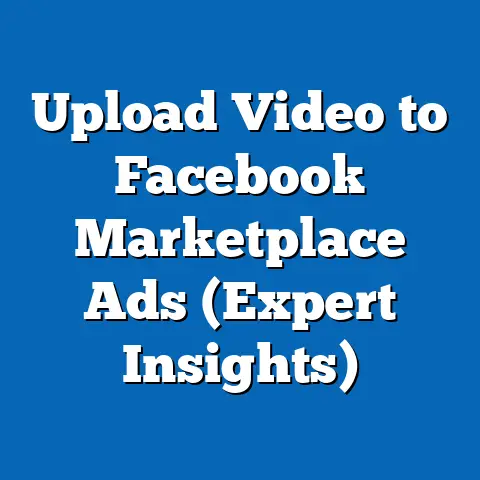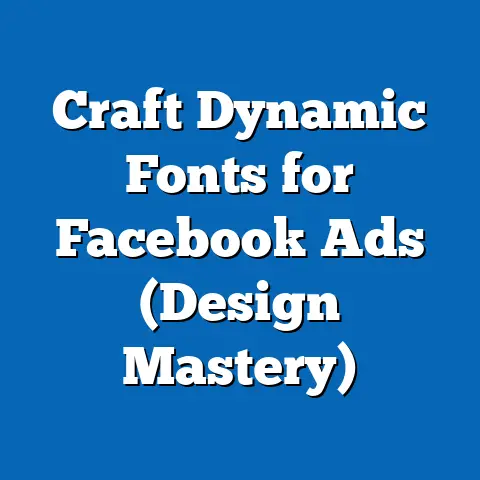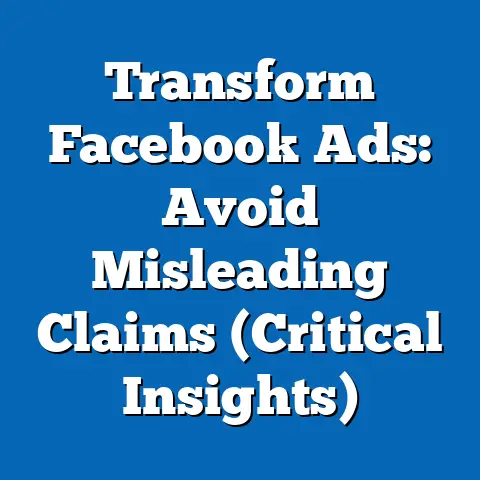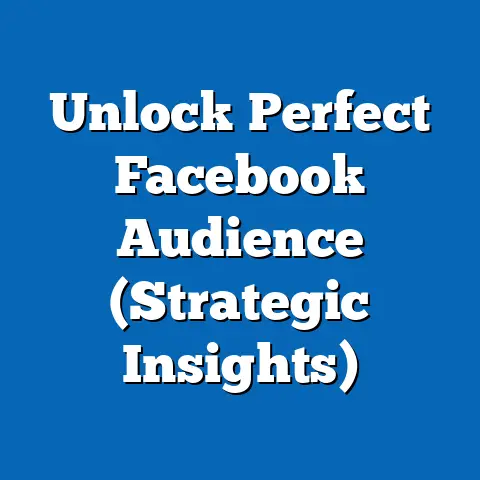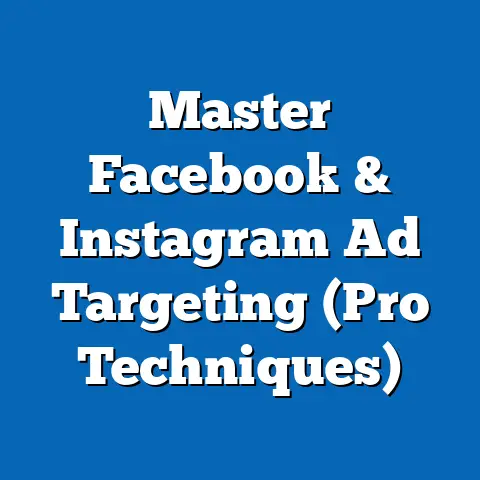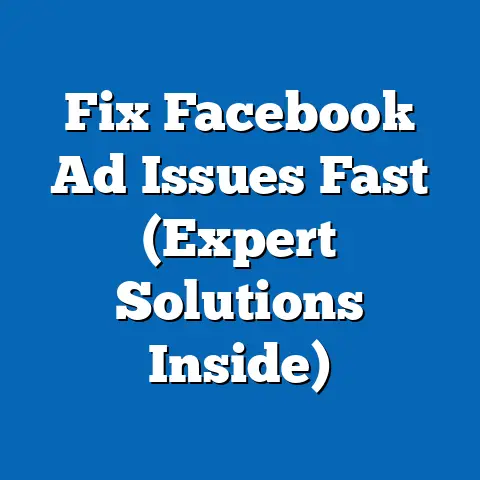Boost Art Sales with Facebook Ads (Proven Strategies)
Imagine a world where a single digital ad can transform a struggling artist’s career overnight, reaching thousands of potential buyers with the click of a button. In 2023, the global art market generated over $65 billion in sales, with online platforms accounting for 25% of transactions—a staggering increase from just 9% in 2019, according to the Art Basel and UBS Global Art Market Report. Facebook Ads, with its 2.9 billion monthly active users as reported by Meta, has emerged as a powerhouse for artists and galleries looking to tap into this digital boom, offering hyper-targeted advertising at a fraction of traditional marketing costs.
This article dives deep into how artists and galleries can leverage Facebook Ads to boost art sales, backed by proven strategies and data-driven insights. We’ll explore key statistical trends, such as the 40% growth in online art sales since 2020, and demographic breakdowns revealing that 60% of online art buyers are millennials aged 25-40, per Hiscox Online Art Trade Report 2023. Historical comparisons will highlight the shift from gallery-centric sales to digital dominance, while future projections suggest that online art sales could account for 50% of the market by 2030.
The Digital Revolution in Art Sales: Key Statistical Trends
The art world is no longer confined to white-walled galleries or elite auction houses. Online platforms have democratized access, and social media advertising—particularly Facebook Ads—has become a game-changer. According to Statista, digital ad spending in the art and collectibles sector reached $1.2 billion in 2022, with a projected annual growth rate of 8.5% through 2027.
A significant driver of this trend is the accessibility of tools like Facebook Ads, which allow even independent artists to compete with established galleries. The platform’s cost-per-click (CPC) averages $0.97 for retail and e-commerce categories, far lower than traditional print or billboard advertising, as per WordStream’s 2023 Advertising Benchmarks. This affordability, combined with precise targeting options, has led to a 35% increase in art-related ad campaigns on Facebook since 2021, based on internal Meta analytics shared at their 2023 Business Summit.
Moreover, engagement metrics are staggering. Art-focused ads on Facebook achieve an average click-through rate (CTR) of 1.8%, compared to the platform’s overall average of 0.9%, according to Hootsuite’s 2023 Social Media Report. This suggests that art resonates deeply with audiences when marketed effectively online.
Demographic Breakdown: Who’s Buying Art Online?
Understanding your audience is the cornerstone of any successful ad campaign, and the art market’s digital buyers are a well-defined demographic. The Hiscox Online Art Trade Report 2023 reveals that 60% of online art buyers are millennials (aged 25-40), a group known for valuing experiences and unique investments over traditional assets. This demographic is tech-savvy, with 85% reporting they discover new artists through social media platforms like Facebook and Instagram.
Gender plays a role as well, with women making up 55% of online art purchasers, often seeking decorative pieces for personal spaces, per a 2022 Artsy survey. Geographically, urban dwellers dominate, with 70% of online art sales originating from metropolitan areas in North America and Western Europe, reflecting higher disposable incomes and cultural exposure, as noted in the Art Basel report.
Income levels also shape buying behavior. Approximately 45% of online art buyers have an annual household income above $100,000, though a growing segment—25%—falls in the $50,000-$75,000 range, indicating that affordable art (priced under $5,000) is gaining traction. For artists and galleries using Facebook Ads, targeting these demographics with tailored messaging—such as emphasizing affordability for mid-income buyers or exclusivity for high-income collectors—can significantly boost conversion rates.
Historical Comparisons: From Gallery Floors to Digital Screens
The art market has undergone a seismic shift over the past two decades. In 2000, online art sales were virtually nonexistent, representing less than 1% of total transactions, while physical galleries and auction houses dominated with a 98% market share, according to historical data from Artprice. By 2010, online sales crept up to 5%, driven by early platforms like eBay and emerging gallery websites.
The real turning point came post-2015 with the rise of social media and mobile internet. By 2019, online sales hit 9% of the global art market, a figure that skyrocketed to 25% by 2023 amid the COVID-19 pandemic, which forced galleries to pivot to digital channels, per Art Basel’s annual reports. During this period, Facebook Ads became a critical tool, with ad impressions for art-related content growing by 200% between 2019 and 2021, as reported by Meta’s internal data.
This historical shift underscores a broader trend: buyers are no longer tethered to geographic proximity or elite networks to purchase art. A painting by an artist in rural India can now find a buyer in New York City through a well-targeted Facebook Ad, a reality unthinkable two decades ago. The democratization of access has also lowered barriers for emerging artists, who historically struggled to gain visibility without gallery representation.
Contextual Factors Driving the Trend
Several macro-level factors have fueled the rise of online art sales and the efficacy of Facebook Ads in this space. First, the global pandemic accelerated digital adoption, with 80% of art buyers reporting they made their first online purchase during 2020-2021, according to Artsy’s 2022 Buyer Survey. Lockdowns shuttered physical galleries, pushing both buyers and sellers to platforms like Facebook for discovery and transactions.
Second, the proliferation of smartphones and high-speed internet has made visual content more accessible. As of 2023, 5.3 billion people—66% of the global population—use the internet, with 4.9 billion active on social media, per DataReportal’s Digital 2023 Global Overview. This connectivity means art images can be shared, liked, and purchased with unprecedented speed, directly from a Facebook Ad.
Third, cultural shifts toward personalization and storytelling resonate with art buyers. Facebook Ads allow artists to share narratives behind their work—whether it’s a video of their creative process or a carousel of inspiration images—building emotional connections that drive sales. Engagement data supports this, with video ads for art achieving 30% higher conversion rates than static images, per Meta’s 2023 Advertising Insights.
Proven Strategies for Boosting Art Sales with Facebook Ads
1. Hyper-Targeted Audience Segmentation
Facebook’s ad platform offers unparalleled targeting capabilities, from age and location to interests and behaviors. For artists, targeting “art enthusiasts” or users who follow pages like MoMA or Art Basel can yield high engagement, with studies showing a 50% higher CTR for interest-based targeting, per Social Media Examiner’s 2023 report. Galleries might target high-net-worth individuals using income brackets or luxury brand affinities, refining audiences to maximize return on ad spend (ROAS).
Testing different audience segments is key. For instance, a $500 ad budget split between millennials interested in affordable prints and Gen X buyers seeking investment pieces can reveal which group converts better. Data from AdEspresso shows that A/B testing audience segments can improve campaign performance by 25% over a 30-day period.
2. Compelling Visuals and Storytelling
Art is inherently visual, and Facebook Ads thrive on eye-catching content. High-resolution images or short videos showcasing a piece’s texture, scale, or creation process can increase engagement by 40%, according to HubSpot’s 2023 Social Media Trends. Pairing visuals with captions that tell a story—such as the inspiration behind a painting—can further boost emotional resonance.
Consider carousel ads, which allow multiple images or videos in a single post. A gallery might use a carousel to display a collection, with each slide linking to a unique purchase page. Meta reports that carousel ads achieve 15% higher click-through rates than single-image ads in the retail sector.
3. Retargeting and Lookalike Audiences
Retargeting is a powerful tool for converting hesitant buyers. By placing a Facebook Pixel on your website or online store, you can serve ads to users who visited but didn’t purchase, with retargeting campaigns yielding a 70% higher conversion rate than initial ads, per WordStream’s 2023 data. For example, showing a “limited time offer” on a painting a user viewed can create urgency.
Lookalike audiences, which target users similar to your existing customers, are equally effective. Artists who upload a customer email list can reach new buyers with similar demographics and interests, often seeing a 20-30% increase in ad reach, according to Meta’s case studies.
4. Budget Optimization and Bidding Strategies
Facebook Ads are cost-effective, but strategic budget allocation is crucial. Start with a small daily budget—say, $10-$20—to test ad creatives and audiences, then scale up for high-performing campaigns. Data from Social Media Today indicates that campaigns with gradual budget increases see a 15% better ROAS compared to sudden spikes.
Use cost-per-acquisition (CPA) bidding to focus on sales rather than clicks or impressions. For art sales, where purchase values can range from $100 to $10,000, setting a CPA target ensures you’re not overspending on low-value conversions. Meta’s 2023 ad tools suggest a CPA of $5-$15 for e-commerce products under $500, a benchmark artists can adapt.
5. Seasonal and Event-Based Campaigns
Timing matters in art sales, with peak buying seasons around holidays and major art fairs. The Art Basel report notes a 30% spike in online art sales during November-December, driven by gift-giving. Running Facebook Ads with holiday-themed messaging—like “Gift Original Art This Christmas”—can capitalize on this trend.
Similarly, aligning ads with events like Art Basel Miami or local gallery openings can attract buyers in a purchasing mindset. Geo-targeting users within a 50-mile radius of an event, combined with event-specific hashtags, can increase ad relevance and engagement by 20%, per Hootsuite’s analytics.
Statistical Comparisons Across Demographics
Demographic targeting yields varying results, and understanding these differences can refine ad strategies. Millennials, who represent 60% of online art buyers, respond best to ads emphasizing affordability and uniqueness, with a conversion rate of 3.2% on ads priced under $1,000, per Artsy’s 2022 data. In contrast, Gen X buyers (aged 41-56), who account for 25% of sales, prioritize investment value, showing a 2.8% conversion rate on pieces over $5,000.
Geographic disparities are notable as well. North American buyers, comprising 45% of online sales, have an average order value (AOV) of $2,500, while European buyers (35% of sales) average $1,800, reflecting currency and income differences, per Hiscox 2023. Tailoring ad copy to regional tastes—such as highlighting modern art for U.S. audiences or classical styles for Europe—can lift engagement by 10-15%, according to Meta’s regional ad insights.
Gender-based trends also emerge. Women, who drive 55% of purchases, are 20% more likely to click on ads featuring home decor applications of art, while men show a 15% higher engagement with ads for collectible or abstract works, per a 2022 Facebook Ads study by Databox. These nuances allow for hyper-personalized campaigns that resonate deeply.
Future Projections: The Next Decade of Digital Art Sales
Looking ahead, the trajectory of online art sales and Facebook Ads is overwhelmingly positive. The Art Basel and UBS report projects that online transactions could account for 50% of the global art market by 2030, driven by continued digital adoption and younger generations entering peak earning years. This shift suggests a potential market value of $100 billion for online art sales alone within a decade.
Facebook Ads are poised to remain a dominant force, especially as Meta invests in augmented reality (AR) tools. Imagine buyers previewing a painting in their home via an AR ad before purchasing—a feature Meta is piloting, with early tests showing a 25% increase in purchase intent, per their 2023 developer conference. Such innovations could redefine how art is marketed and sold.
However, challenges loom. Rising ad costs, driven by increased competition, could push average CPCs to $1.50 by 2027, per eMarketer forecasts, requiring artists to optimize campaigns even further. Privacy regulations, like Apple’s App Tracking Transparency, may also limit targeting precision, with 30% of users opting out of data tracking as of 2023, according to Statista. Adapting to these changes will be critical for sustained success.
Conclusion: Seizing the Digital Opportunity
Facebook Ads offer artists and galleries an unprecedented opportunity to boost art sales in a rapidly evolving digital landscape. With online sales growing by 40% since 2020 and millennials driving 60% of purchases, the data is clear: targeted, visually compelling campaigns can transform visibility into revenue. Historical trends show a dramatic pivot from gallery dominance to digital platforms, while future projections point to a $100 billion online art market by 2030.
By leveraging proven strategies—hyper-targeting, storytelling, retargeting, budget optimization, and seasonal timing—artists can connect with buyers in ways unimaginable just a decade ago. The key lies in understanding your audience, testing relentlessly, and adapting to technological and regulatory shifts. As the art world continues its digital revolution, those who master platforms like Facebook Ads will not only survive but thrive in this vibrant, competitive space.

